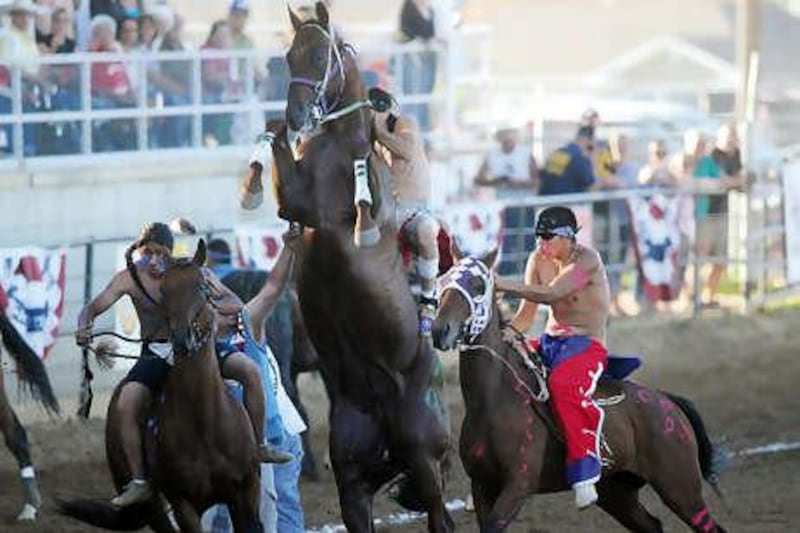Summer has brought another season of Indian Relay racing to the northern Rockies and high plains of the United States, sending tribal teams in motion across the region as they haul their horses in search of reservation jackpots, rodeo purses and bragging rights. Paying tribute to their cultural reverence for horses, horsemanship and bravery, Native Americans speed bareback around a track, then jump from one mount to the next amid a jumbled mass of rearing steeds.
Think horse racing with pit stops. "It's a lifestyle really," said Jostin Lawrence, the co-owner of an Indian Relay team from the Blackfeet Nation in Browning, Montana. "We're always on the road. If we're not on the road, we're with our horses." Lawrence's team was one of 24 that gathered in Sheridan, in the state of Wyoming, on a July weekend for four nights of racing at the Sheridan WYO Rodeo. The meeting, which offered US$25,000 (Dh91,800) in prize money, included teams from tribes in Montana, South Dakota, Washington and Idaho.
"It's very competitive," said Lawrence as his team prepared their horses for a race. "We got all these teams here and they're all vying for that championship spot. It's like any kind of racing. You've got your fights in the back, you've got your friends and buddies. Other teams have rivals. So it can be pretty intense. The crowds love it." The races have become a big draw since they were reintroduced at the Sheridan rodeo 14 years ago, said Zane Garstad, the vice president of the rodeo board. Even the professional cowboys hop on the arena fence to watch the action.
"I know local people who would say 'I don't mind the rodeo, but I really enjoy the Indian Relay races'," Garstad said. "So we've brought another group of people to the show." The rules of Indian Relay are simple. Teams consist of four people and three horses. A team's rider makes three laps around the track, changing to a new horse at the beginning of each lap. Two teammates stand at the edge of the track holding and calming the waiting horses for the incoming rider. The fourth teammate's job is to catch the arriving horse while the rider dismounts and leaps onto the next horse.
The exchanges are the sport's signature action. At Sheridan, the mild roar of the crowd escalated into full-throated cheering as the six riders charged back into the arena from the half-mile track. The catchers waved their riders in for the exchange, and the holders shoved them on their way, cursing or clapping, depending on their results. A perfect exchange is beauty in motion. The rider leaps off his horse and bounces one or two steps before vaulting on to the next horse and hugging its neck tightly as it takes off for another lap.
But with 24 people and 18 horses all working in an area about the size of a basketball court, complications are common. Horses get excited and start dragging their holders around. Horses throw riders, rearing or taking off before the rider has a firm hold. Accelerating horses crash into one another or trample the holders. Bumps and bruises are common, and broken bones are not unusual. "Every position on the team is dangerous," Lawrence said. "Anything can happen at any time. Horses hitting you from another team, your own horse blowing up."
Participants view the event as a cultural and spiritual connection to their forefathers and the historic tribal practices of warfare and hunting. Some point to how hunters would herd bison over long distances to force them over cliffs, jumping on new horses at relay points along the way. Others hearken to raids in which one tribe would steal another's horses and take them home. "They would tether their horses along the route," said Shawn Real Bird, a Crow tribal member from Montana and a coordinator of the Sheridan Indian Relay.
"They were herding them back, and they would jump on a fresh horse every so often all the way back to their home area." The origins of organised Indian Relay racing are unclear. LaGrand Coby, the president of the Shoshone-Bannock Relay Association, said the eastern Idaho reservation has been running Indian Relays as part of tribal fairs since the early 1900s. Racers relish the competition with other tribes.
"I do it for fun, but there's still the bragging rights that everyone wants from every different nation," said Wade Amyotte, 24, a Crow rider from Montana, and a two-time champion at Sheridan. "It's the same as a long time ago, the bragging rights." Prize money also fuels the competition. It helps the teams pay for petrol, horse feed and new horses. The teams race different breeds, mostly thoroughbreds, purchased from racetracks across the country.
At the Sheridan race, the team members camped with their families in tents and horse trailers at the fairground stables. It is one of several opportunities each summer to race in front of big audiences at western rodeos and fairs, interspersed with smaller races on their reservations. The races help promote and preserve Native American horse culture, Real Bird said. "It also gives these young men a goal so they can ride their horses, exercise their horses and lead a good clean healthy lifestyle.
"It's a new beginning for each and every Indian Relay racer every time they run a new race." * AP





